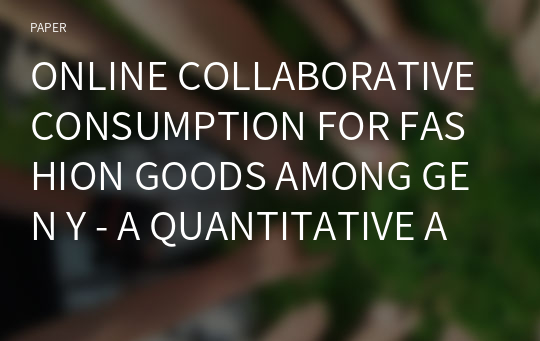ONLINE COLLABORATIVE CONSUMPTION FOR FASHION GOODS AMONG GEN Y - A QUANTITATIVE APPROACH
* 본 문서는 배포용으로 복사 및 편집이 불가합니다.
서지정보
ㆍ발행기관 : 글로벌지식마케팅경영학회(GFMC)
ㆍ수록지정보 : GFMC Session1
ㆍ저자명 : Doris Berger-Grabner, Marion Fett
ㆍ저자명 : Doris Berger-Grabner, Marion Fett
영어 초록
Initial situation and Problem StatementThe world faces extraordinary challenges relating to the environment and society. Rapidly increasing demand is colliding with declining resources, the awareness of the need for environmental and social sustainability has grown (Martin & Schouten, 2014, p. 20). Due to these facts collaborative consumption has emerged and has disrupted various established industries all over the world. People’s attitude towards ownership and the way societies consume are changing (Chen, 2009, p. 926).
Today, consumers are willing to pay for using or accessing a product rather than buying or owning it (Chen, 2009, p. 926). Gradually, consumers are turning their backs on the traditional consumer-oriented paradigm and over-consumption and are progressively looking for ways which downshift or simplify their lives (Albinsson, Wolf, & Kopf, 2010, p. 414).
Collaborative consumption is driven by a variety of factors including the global recession, anti-hyper-consumerism, cost-consciousness as well as awareness of the need for a waste-reducing and sustainable living (Gansky, 2010, p. 16). The main drivers are technological advances, such as the internet and social media, which allow new ways of accessing and sharing. By using information technology, products and services can be reused, distributed and shared at the right time and location to the right customer (Gansky, 2010, p. 16).
The most successful field of collaborative consumption is the one of tangible assets, such as clothing, which are not used to their full potential by their owners and can be therefore temporarily shared (Botsman & Rogers, 2010, p. XVI). Within the fashion industry many collaborative consumption concepts are developing and thriving (Pedersen & Netter, 2015, p. 259). Generation Y is interested in collaborative consumption and can identify with this phenomenon as it fits their increasingly ideological lifestyles (Höflehner, 2015). According to a study published by Mindshare in November 2015, 44 % of persons of Generation Y in Austria are aware of the prominent online collaborative consumption platforms and one out of ten has already participated in a fashion-sharing activity (Mindshare, 2015).
In 2014, 8.5 billion euros were spent on clothing (Statista, 2016), whereas almost 60 % consisted of fast fashion items (Ökosoziales Forum, 2013). On average, a person has 90 clothing items in their wardrobe, and more than half, is not used at all any more. Moreover, the average item is worn for about a month before its usage drops significantly (Threadflip, 2014) or the item gets disposed of in spite of still being in good condition (Shephard & Pookulangara, 2014, p. 11). Online collaborative consumption for fashion can help expand products’ life-cycles, as unneeded or unwanted fashion items can be easily rented, lent, given or sold to other consumers by using various online platforms available (Fletcher & Grose, 2012, p. 88).
However, hardly any research was found that specifically focus on online collaborative consumption for Gen Y and examine the influencing factors
Research Aim and Research Methods
The aim of this study was to find out about the determinants influencing the intention to participate in online collaborative consumption for fashion items among Gen Y taking as an example young adults in Austria. Additionally, the factors, which can increase participation should be identified. In order to find out the influencing determinants, the Unified Theory of Acceptance and Use of Technology 2 of Venkatesh et al. (2012) will serve as the basis for the applied research construct. The following research questions are to be answered in this study:
RQ: Which factors have an influence on consumer's intention to participate in online collaborative consumption for fashion among Generation Y in Austria?
SubQ: Which measures help Generation Y in Austria to be more motivated to participate in online collaborative consumption for fashion?.
In order to be able to provide answers to the research questions a quantitative study in the form of an online questionnaire (n= 219) among respondents of Gen Y in Austria was carried out. A number of research hypotheses have been developed in order to identify a possible influence of several variables on the intention to participate in online collaborative consumption for fashion items, mainly focusing on the Theory of Planned Behaviour (Ajzen, 1991) and on the Theory of Acceptance and Use of Technology 2 of Venkatesh et al. (2012).
Theoretical Background
Theory of Planned Behaviour by Ajzen (1991)
The Theory of Planned Behaviour (TPB) was presented by Ajzen in 1991 as an extension of the Theory of Reasoned Action (TRA) by Ajzen and Fishbein, introduced in 1975 (Teo & Lee, 2010, p. 60).
Both models are part of the multiattribute models. The theory of reasoned action tries to offer an explanation for a performed behaviour. The idea behind the theory is that behaviour is performed due to an intention to perform that behaviour. The intention is influenced by the subjective norm and the attitude towards the behaviour. The TRA thereby attempts to predict the possibility of the occurrence of a specific behaviour (Schwenkert, 2006, p. 27). Although it can be said that no behaviour can be predicted with a 100% certainty there are several studies that unveil that the intention to perform a behaviour makes a significant contribution to the actual performance. The intention is the motivational factor behind the behaviour. It indicates “how hard people are willing to try, of how much of an effort they are planning to exert, in order to perform the behaviour” (Ajzen, 1991, p. 180).
The main variables of the model are the Subjective Norm and the Attitude towards the Behaviour. Subjective Norm (SN) can be described as the assumption of the individual that people important to the individual are expecting the behaviour to be performed. In other words, that people close to the individual think that the behaviour should be performed by him or her (Schwenkert, 2006, pp. 27-28; Teo & Lee, 2010, p. 61). This belief somehow conveys a sense of unconscious social pressure for the individual – the pressure to perform as the norm demands. Some researchers have found that the social norm does not have as much influence on the intention to perform a specific behaviour as originally assumed (Li, Mizerski, Lee & Liu, 2009, p. 233). It has been found that the culture also tends to have an impact on the influence of the Subjective Norm. People living in an individualistic culture have a tendency to be not as influenced by social pressure as people living in a collectivistic culture (Li et al., 2009, p. 234). This may result in the fact that in collectivistic cultures the opinion of the group is highly important and therefore often followed. In individualistic cultures people are not that influenced by others which may explain those differences in the impact of the Subjective Norm.
The TRA involves another variable – the Attitude towards the Behaviour (AtB). As the phrase already suggests, it does not describe the attitude towards an object, but the attitude towards the behaviour itself (Schwenkert, 2006, p. 27). The individual has a positive or negative feeling about the behaviour which influences the intention to perform it, is influenced. The attitude towards a specific behaviour is connected with one’s inner beliefs about the consequences of executing it. Therefore, also the possible consequences and outcomes of the behaviour are evaluated. If they are seen or predicted as positive the possibility of the intention to exert the behaviour is high, and so is the possibility of an actual performance (Li et al., 2009, p. 233; Teo & Lee, 2010, p. 61).
As the Theory of Planned Behaviour (TPB) is an extension of the TRA, there has been added another variable – the Perceived Behavioural Control (PBC). The PBC points out the “perceived ease or difficulty of performing the behaviour” (Li et al., 2009, p. 234). By adding this variable Ajzen tried to include the element of uncertainty and to increase the ability to predict the behaviour. Studies show that the accuracy of prediction is higher than with the TRA but still the cognitive processes are in the foreground (Kroeber-Riel & Gröppel-Klein, 2013, p. 236).
Unified Theory of Acceptance and Use of Technology by Venkatesh et al. (2012)
The original Unified Theory of Acceptance and Use of Technology (UTAUT) was constructed by Venkatesh et al. in 2003 after reviewing eight existing popular models for IT adoption. The eight models revised were The Model of PC Utilisation, Innovation Diffusion Theory, Social Cognitive Theory (SCT), Motivational Model (MM), Theory of Reasoned Action (TRA), Technology of Acceptance Model (TAM and TAM2), Theory of Planned Behaviour (TPB) and the Combined TAM/TPB (Venkatesh, Morris, Davis, & Davis, 2003, pp. 428-433).
The UTAUT was mainly created for IT corporate use. The extension, the UTAUT2, was developed in 2012 by Venkatesh et al. to make it applicable in consumer contexts and it is used to study new technology applications (Venkatesh, Thong, & Xu, 2012, p. 158). The UTAUT2 consists of seven variables that have an influence on Behavioural Intention. Behavioural Intention is a determinant for adoption of the Use Behaviour.
Variables that refer to an individual’s difference, namely age, gender and experience, are used to moderate various relationships within the model.
Performance Expectancy is the extent to which consumers gain benefits in their performance when using a technology. From reviewing the eight prior models, Venkatesh et al. (2003) have developed the construct Performance Expectancy, which pertains to Perceived Usefulness (TAM/TAM2), Outcome Expectations (SCT) and Extrinsic Motivation (MM), which refers to the behaviour that is driven by external rewards. According to Venkatesh et al. (2003) it is the strongest predictor of Behavioural Intention (Venkatesh, Morris, Davis, & Davis, 2003, p. 447).
Effort Expectancy is the “degree of ease associated with consumers’ use of technology” (Venkatesh, Thong, & Xu, 2012, p. 159). In general, the easier a technology it is to use in the adoption phase, the more positive the attitude towards said technology (ibid.).
Social Influence is defined as the degree to which consumers think it is important that others, such as family and friends, believe they should use a certain technology. This construct refers to the Subjective Norm in TRA and TBP. Prior research suggests that individuals, who are not well informed about the technology in question, are more likely to intend to use the technology, if other, well-informed, peers use said technology (Venkatesh, Morris, Davis, & Davis, 2003, p. 453).
Facilitating Conditions refer to the extent to which consumers “believe that an organisational and technical infrastructure exists to support use of the system” (Venkatesh, Morris, Davis, & Davis, 2003, p. 453).
Hedonic Motivation, or intrinsic motivation, refers as the enjoyment or pleasure derived from using a technology. It is shown to be an important factor in determining technology acceptance and use in consumer contexts (ibid.).
Price Value is an important value in a consumer use setting as the consumer usually pays for the technology application or the use of it. The Price Value is positive and adds to explaining the Behavioural Intention to use when the benefits of using the technology perceive to outweigh the costs (ibid.).
Finally, Habit is the degree to which people tend to behave automatically because of learning (Limayem, Hirt, & Cheung, 2007, p. 718).
Conclusions
Summary
The empirical study has shown that the factors Effort Expectancy, Social Influence, Facilitating Conditions, Hedonic Motivation, Price Value and Sustainability have an influence on the Behavioural Intention to participate in online collaborative consumption for fashion.
Firstly, it has been hypothesized that Performance Expectancy has an influence on the intention to use online collaborative consumption for fashion. As it turns out, the results showed no significant difference. Therefore, consumers might find other ways of acquiring clothing more appropriate and better suited.
The second examined factor is Effort Expectancy, defined as how easy it is for consumers to use the technology. The results display that this factor shows a significant, positive influence on the intention to participate. This is in accordance with results of Venkatesh et al. (2012, p. 159), stating that the easier a technology is to use, the more likely is its adoption.
The third factor, Social Influence, explains whether consumers feel it is important that other people, such as family and friends, think they should use a technology. As it turns out, this variable is positively and highly significantly related to the adoption of online collaborative consumption for fashion. Prior research proposes that persons, who are less informed about the technology, are more likely to use it if other influential persons use said technology (Venkatesh, Morris, Davis, & Davis, 2003, p. 453).
Next, Facilitating Conditions were investigated as a potential factor influencing the intention to participate in online collaborative consumption for fashion. It was hypothesized that Facilitating Conditions, such as the access to a technological device with access to the Internet, have an influence on the adoption of online collaborative consumption. According to the results of the study, this variable has a highly significantly correlation to the outcome variable Behavioural Intention.
The results also show that Hedonic Motivation is significantly and positively related to the Behavioural Intention. Thus, utilitarian and hedonic components of online consumption need to be taken in consideration, as has been shown by previous research in the context of traditional online shopping (Childers, Carr, Peck, & Carson, 2001, p. 533).
The sixth investigated factor was Price Value, which is considered positive when the benefits of using the technology perceive to outweigh the costs. In this research, Price Value is a positive and highly significant predictor for the intention to use online collaborative consumption for fashion. Therefore, the outcomes of the study show that Price Value influences the intention to participate in online collaborative consumption for fashion.
The next two factors of the research model, Trust and Sustainability, played a tremendous role when discussing collaborative consumption and even are considered main principles of collaborative consumption in the literature. As expected, Sustainability showed a highly significant and positive impact on Behavioural Intention. As mentioned before, this predictor accounted for 28 % of the total contribution of the research model.
Trust did not significantly influence the adoption of online collaborative consumption for fashion. This result might be based on the fact that respondents feel insecure when interacting with strangers on the Internet in order to sell, buy or rent fashion items.
Managerial Implications
Several implications for retailers could be deduced from the results:
According to this study, especially the factors Hedonic Motivation and Sustainability account each for 28 % of explaining the contribution to Behavioural Intention to use online collaborative consumption for fashion.
Considering these insights, platforms dedicated to online collaborative consumption for fashion might put emphasis on these factors and increase their level of enjoyment and social interaction. For instance, platforms could boost these factors by including the usage of gamification. This way, the level of fun and pleasure for persons can be enhanced which in turn may lead to the adoption of online collaborative consumption behaviour. Additionally, in order to increase the social factor, online forums and discussion groups might not only help to express users’ experiences, reviews or interests, but also generate general social interaction, which is considered as very important for the participation in collaborative consumption.
Furthermore, the study has shown that two thirds of the sample would welcome the possibility of fast fashion retailers offering online collaborative consumption activities. Since there are still a limited number of persons aware of the phenomenon of collaborative consumption, the alternative of peer-to-peer exchange in collaboration with a prominent fast fashion retail chain would be a perfect alternative. Instead of being tied to relatively unknown platforms dedicated to collaborative consumption for fashion, persons would most certainly be more aware and more willing to participate in such practices, if a well-known, established retailer would allow collaborative activities.
Moreover, the aspect of sustainability seemed to be a crucial factor for the intention to use online collaborative consumption platforms for fashion. For this reason, platforms should communicate this aspect and publicise the fact that using collaborative consumption activities is an environmentally friendly,
To conclude with, more than half of respondents would need more information about the topic in order to participate. Existing online platforms should invest in effective communication strategies or inexpensive guerrilla campaigns in order to attract more users. As the results of this study show, if persons are better informed and more aware of this phenomenon and its advantages, the better are the chances for adoption of collaborative consumption for fashion.
참고 자료
없음태그
"GFMC Session1"의 다른 논문
 FAST AND SLOW FASHION BRANDS IN DEVELOPING SUSTAINABLE ..6페이지
FAST AND SLOW FASHION BRANDS IN DEVELOPING SUSTAINABLE ..6페이지 “WHAT IF A CELEBRITY AND A BRAND CO-CREATE A NEW COLLEC..7페이지
“WHAT IF A CELEBRITY AND A BRAND CO-CREATE A NEW COLLEC..7페이지 THE INSTAGRAM’S STRATEGY IN ENGAGING THE CUSTOMER’S LOY..3페이지
THE INSTAGRAM’S STRATEGY IN ENGAGING THE CUSTOMER’S LOY..3페이지 THE PARTICULARITIES OF NEW PRODUCT DEVELOPMENT IN THE T..5페이지
THE PARTICULARITIES OF NEW PRODUCT DEVELOPMENT IN THE T..5페이지 THE LONE CHOCOLATE BAR: THE INFLUENCE OF PERCEIVED SCAR..6페이지
THE LONE CHOCOLATE BAR: THE INFLUENCE OF PERCEIVED SCAR..6페이지 ADS AS WORKS OF ART: MEASURING ADVERTISING IMMERSION3페이지
ADS AS WORKS OF ART: MEASURING ADVERTISING IMMERSION3페이지 ECONOMIES OF SMALL: NICHE STRATEGIES AND SUCCESS FACTOR..8페이지
ECONOMIES OF SMALL: NICHE STRATEGIES AND SUCCESS FACTOR..8페이지 THE INFLUENCE OF ONLINE CUSTOMER REVIEWS ON RETAILERS' ..6페이지
THE INFLUENCE OF ONLINE CUSTOMER REVIEWS ON RETAILERS' ..6페이지 IS THE ARTIFICATION PROCESS PERCEIVED BY FINAL CONSUMER..6페이지
IS THE ARTIFICATION PROCESS PERCEIVED BY FINAL CONSUMER..6페이지 THE ODD EVEN PRICE PARADOX IN THE FASHION LUXURY SECTOR6페이지
THE ODD EVEN PRICE PARADOX IN THE FASHION LUXURY SECTOR6페이지


























